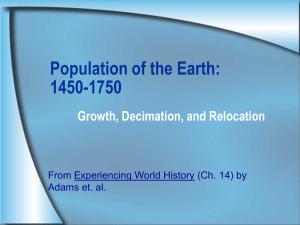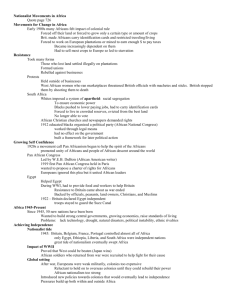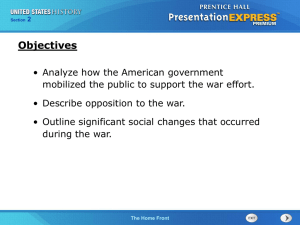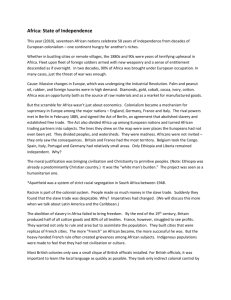Africa`s First World War
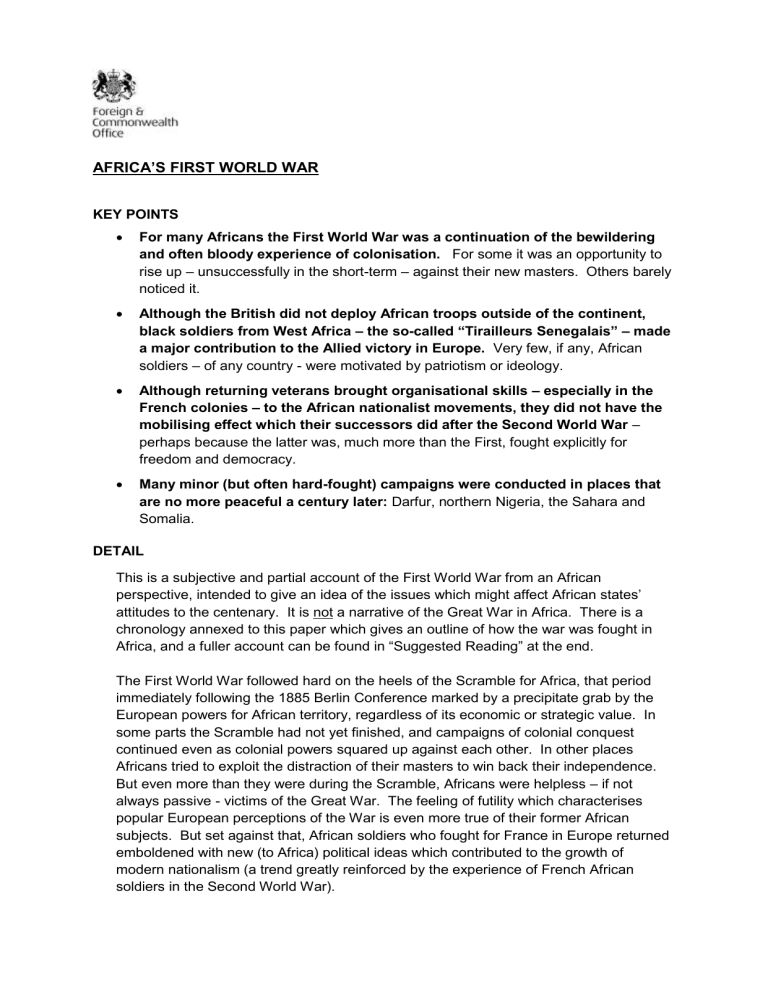
AFRICA’S FIRST WORLD WAR
KEY POINTS
For many Africans the First World War was a continuation of the bewildering and often bloody experience of colonisation. For some it was an opportunity to rise up – unsuccessfully in the short-term – against their new masters. Others barely noticed it.
Although the British did not deploy African troops outside of the continent, black soldiers from West Africa – the so-called “Tirailleurs Senegalais” – made a major contribution to the Allied victory in Europe. Very few, if any, African soldiers – of any country - were motivated by patriotism or ideology.
Although returning veterans brought organisational skills – especially in the
French colonies – to the African nationalist movements, they did not have the mobilising effect which their successors did after the Second World War – perhaps because the latter was, much more than the First, fought explicitly for freedom and democracy.
Many minor (but often hard-fought) campaigns were conducted in places that are no more peaceful a century later: Darfur, northern Nigeria, the Sahara and
Somalia.
DETAIL
This is a subjective and partial account of the First World War from an African perspective, intended to give an idea of the issues which might affect African states’ attitudes to the centenary. It is not a narrative of the Great War in Africa. There is a chronology annexed to this paper which gives an outline of how the war was fought in
Africa, and a fuller account can be found in “Suggested Reading” at the end.
The First World War followed hard on the heels of the Scramble for Africa, that period immediately following the 1885 Berlin Conference marked by a precipitate grab by the
European powers for African territory, regardless of its economic or strategic value. In some parts the Scramble had not yet finished, and campaigns of colonial conquest continued even as colonial powers squared up against each other. In other places
Africans tried to exploit the distraction of their masters to win back their independence.
But even more than they were during the Scramble, Africans were helpless – if not always passive - victims of the Great War. The feeling of futility which characterises popular European perceptions of the War is even more true of their former African subjects. But set against that, African soldiers who fought for France in Europe returned emboldened with new (to Africa) political ideas which contributed to the growth of modern nationalism (a trend greatly reinforced by the experience of French African soldiers in the Second World War).
By 1914 all of the western European powers had major holdings in sub-Saharan Africa.
In spite of being the largest landowner there, Britain always considered it secondary to
India, the “Jewel in the Crown”. But it was home to much of the French empire, most of the German and Italian, and all of the Belgian. There were only two independent territories, Liberia and Ethiopia, the former a virtual American colony and the latter only free because of some deft diplomatic (and military) footwork at the end of the 19 th century. Although the continent had almost provoked European wars (including the famous Fashoda incident in 1898 1 ),all of the colonial authorities got on fine with their neighbours, sharing the “white man’s burden”.
There was little to choose between colonial authorities. The ruthlessness which had characterised the Scramble (and the early excesses of Belgian and German colonialism) was tempered by the humanitarian (if paternalistic) impulses which had always been part of Europe’s approach to Africa. The colonial authorities looked forward – as far as scarce resources allowed – to bettering the lives of their charges (mostly by making them productive units in the global economy). All this was overturned by the outbreak of war, which intensified certain aspects of colonialism (economic exploitation, for example) while diminishing others (like education and health care). Again, there was a reverse to this coin in that – for France at least – development became part of a “blood debt” owed to Africans for their sacrifices in the war.
The Berlin treaty had included a clause which forbade the export of European wars to
Africa. Although the governor of German East Africa tried to invoke this clause, any pacific civilian impulses were trumped by their military colleagues, infected by the same bellicosity which afflicted their metropolitan counterparts. Before the end of August 1914
The Times was proclaiming Britain’s “first naval victory in the war” on Lake Nyasa (now
Malawi) an outcome facilitated by the German commander’s ignorance of the outbreak of hostilities. Across the continent Allied forces mobilised to conquer their German neighbours. South Africa – delayed by a short Afrikaner rebellion - was not far behind, anxious to demonstrate that it was a loyal dominion worthy of sharing the spoils of empire.
Most of the German colonies fell relatively quickly. Only in East Africa did they hold out to the end – and beyond. Led by Colonel von Lettow-Vorbeck, the colony’s
Schutztruppe fought a peripatetic guerilla war which took it through Mozambique and
Northern Rhodesia, surrendering only when it heard of the Kaiser’s abdication.
Characteristically, though, LettowVorbeck’s aim had not been to preserve the German colony, but to divert Allied resources from the decisive theatre in Europe. The vast majority of his troops were black Africans, whose tenacity – unwittingly – meant that
South Africa did not get the mandate over German East Africa (also, known as
Tanganyika, now part of Tanzania) which it acquired over South West Africa, which in turn meant Namibia’s independence was delayed almost 30 years after Tanganyika’s.
1 When a French expedition tried to seize south Sudan before the British could recover it from the Mahdists.
Although the “Fashoda Complex” is still blamed for difficulties in the UK-France-Africa relationship, it precipitated the rapprochement between London and Paris (who realised the madness of going to war over an enormous swamp) which created the alliance of European democracies which effectively won the Great War.
Other than in East Africa, the most tenacious resistance to the Allies came from indigenous Africans led by fellow Africans, sometimes in ostensible alliance with the
Turks. Ominously – and not coincidentally – the hardest campaigns were fought in places all too familiar to 21 st century diplomats. A Tuareg rebellion against the French
(in what is now Mali and Niger) linked up with the Senussi rebellion against the Italians
(and their British allies) in Libya, the first and only time until 2012 that Tuareg resistance to outsiders took on the nature of a jihad . In Somalia the socalled “Mad Mullah 2 ” fought a long hard jihad against the British which only spluttered to a close in 1920. Worried that the outbreaks of Islamic militancy in East and West Africa might join up, the British conquered the Sultanate of Darfur in 1916. In northern Nigeria the Native Authority in
Bussa province (south west of Sokoto) was massacred by rebels in June 1915, prompting the despatch of a military expedition.
Of at least equal consequence were the early stirrings of modern African nationalism which, although less successful militarily than their more traditional compatriots, led directly to the mass movements of the 1950s and 60s (and the guerilla movements in southern Africa) 3 . Often missionary educated, and motivated by European liberal ideals of equality and individual freedom, the most representative (and poignant) was the
Chilembwe uprising in Nyasaland (now Malawi). John Chilembwe was an Americaneducated evangelical minister who had started his own church and campaigned against the brutality of officials and exploitation by white farmers. In January 1915 he led a revolt against the colonial administration, but it was rapidly crushed. In a triumph of racial over national loyalty, part of the British defence was organised by a German prisoner of war
(pre-empting Chilembwe’s futile hopes of a German alliance).
Of all the European powers France was probably most attached to its African colonies: which played the same emotional role for French public opinion that India did for the
British. After humiliating the French by capturing Paris (and annexing Alsace-Lorraine) in 1871, German chancellor Bismarck had hoped to encourage the French to play out their military humiliation in West Africa. The French duly responded, leading to a brutal campaign of conquest by virtually autonomous (and often junior) officers frequently beyond civilian control. Although this had unfortunate local consequences, it did create one of the toughest (and cockiest 4 ) armed forces in the world, and the “Coloniale” 5 produced some of France’s leading Great War soldiers. Marchand – the French commander at Fashoda - led a French division at the Somme in 1916 6 . And France was
2 More properly Sayyid Mohammed bin Abdille Hassan
3
In French West Africa in particular, this was reinforced by returning veterans, who brough much needed organisational skills and – ironically – militancy.
4 In 1914, General Mangin found himself sharing a billet with General Petain (later a French hero for his defence of Verdun in 1916, subsequently a villain for his leadership of Vichy France from 1940). Petain watched in wonder as a folding table and chair, a bottle of wine, and a cooked lunch were produced by Mangin’s (African) batman, and asked sarcastically if he knew they were at war. “I have been at war all my life” replied Mangin, “and have never felt better. You, on the other hand, have been at war two weeks and look halfdead”.
5 Separate from the “Armee d’Afrique”, which was the North African colonial army.
6 The Somme is popularly seen as a British battle, but the French made a major contribution (and were generally more effective than their allies).
alone among the colonial powers in deploying black African troops in Europe, the “Force
Noire”, created because France’s birth rate was lower than Germany’s, reducing the pool of French conscripts.
Characteristically, even the Force Noire’s supporters had racial attitudes typical of their time. General Mangin, a “Coloniale” who later played a key role at Verdun, had championed the recruitment of black Africans on the grounds that their nervous systems were resistant to pain. When the hastily-raised and still segregated American
Expeditionary Force was sent to France in 1917 and deployed alongside its allies to gain experience, black American formations were paired with the Colonials – even though they had nothing in common with them except the colour of their skin. Notwithstanding the racism of the time (Germans did not take African prisoners – a practice which was reciprocated), the Force Noire fought hard for France. Whereas the Indian army (which the professional, and therefore tiny, British army had hoped to use as a manpower pool like the Force Noire) was largely withdrawn from the Western Front by the end of 1915,
“la Coloniale” stayed to the end 7 . Black troops bore the brunt of the 1917 French offensives that drove many of their white comrades to mutiny.
A (white) South African Brigade fought at the Somme, as part of the elite 9 th Highland
Division. For white Anglophone South Africa the battle played the same nation-building role that Gallipoli did for the Australians and New Zealanders, and Vimy for the
Canadians – not least as a blood sacrifice expected to earn the “mother country’s” gratitude and respect. But more black Africans than white South Africans fought at the
Somme 8 . And their service was not confined to the Western front: just under 10,000, mostly black African, French soldiers died at Gallipoli (as against 7300 Australians and
2400 New Zealanders). The French would not deploy their North African troops against the Turks, believing religion would test their loyalties. So they used the Force Noire instead – even though the vast majority of black African soldiers were Muslims too.
No other colonial power used black African troops as extensively as the French: the
Belgians, British, Germans and Portuguese kept theirs in Africa. Recruiting locally had generally been an economic measure, combined with a recognition that Africans were more resistant than Europeans to tropical illness. But it was also a fear that too much reliance on black troops might create an “Indian Mutiny” situation in Africa. The South
Africans especially would not recruit black soldiers (although they made great use of black labour), and ensured that the conquest of German South West Africa was conducted only by white forces. They also contributed substantial forces to East Africa
(although health problems meant the final campaigns were largely conducted by black soldiers). Jan Smuts, South African defence minister (and subsequently member of
Lloyd George’s Imperial War Cabinet) even commanded the force for a while, partly in the hope of strengthening South Africa’s post-war territorial claims in East Africa.
7 Although they did benefit from “hivernage”, being withdrawn from the front in winter and redeployed in the south of France.
8 About two division’s worth (a division comprised two brigades) in the two French Colonial Corps at the battle.
South Africa did n’t get the League of Nations Mandate over Tanganyika partly because of the lacklustre performance of their troops in that theatre 9 . But it was also in competition with the India Office which (as in Mesopotamia) wanted a slice of the spoils.
It didn’t get any – at least in Africa – but Indian troops were widely used (and generally performed poorly – the best units had been sent elsewhere), and Indian immigration increased after the war 10 . Indians already dominated the “middle-class” (the British had actively promoted their migration for this reason) and this contributed to later problems, in particular the antiAsian policies of Amin’s Uganda and Banda’s Malawi.
Other than Germany, the only external enemy (to the British) active south of the Sahara were the Turks who were, in a roundabout way, a former colonial power (through their notional rule over Egypt 11 and bits of the Red Sea coast). They only really directly impinged on the Horn, although Turkish weaponry made its way from Libya to the
Tuareg rebels in French West Africa. None of this benefitted the Turks, but the recently crowned emperor of Ethiopia , Lij Yasu (whose mother was Somali, leading to accusations that he was a Muslim), toyed with a Turkish alliance against his domestic enemies. Nothing came of this, but it did lead to allied support for his opponents, including the young noble Ras Tafari, who later became Haile Selassie, the last
Ethiopian emperor. The Arab Revolt effectively blocked any Turkish attempts to help their co-religionists in either Ethiopia or Somalia, although a few old rifles did get through. The Turks also produced the world’s first black fighter pilot, Ahmet Ali Celikten, whose mother was a slave from Nigeria, and who earned his “wings” in 1916 12 .
The First World War d idn’t have the catalytic effect on nationalism in Africa which the
Second one did (and that it had in the Middle East). Partly this was because African societies were still adjusting to “the shock of capture” 13 . One consequence was that the effects of “modernity” had not yet been felt. Whereas the first colonial recruiters sought out the virile but simple attributes believed to belong to the socalled “martial-races”, in
1939 a new generation of soldiers needed to be able to read and write, to operate radios and to drive vehicles. And such men were less likely to return quietly to their villages on demobilisation – especially since the Second World War was fought explicitly for the cause of political freedom.
The burden of servicing the Force Noire (particularly conscription, which was often hard to distinguish from slavery) had profound effects on the administration of French Africa. It probably perpetuated the militarisation of francophone African politics, the effects of
9 A British staff officer recorded that on occasion African porters attached to South African units held their ground when their white comrades had fled.
10 A European settler is quoted in Ernest Hemingway’s “Green Hills of Africa” (a record of a safari in the 1930s)
“You see, during the war they sent the Indian troops to fight here...They promised the Aga Khan that because they fought in Africa, Indians could come freely to settle and for business afterwards. They cannot break that promise and now the Indians have taken over the country.” Although inaccurate, this reflects European settler opinion – and possibly that of many Africans too.
11 Hence the period of Egyptian rule in the Sudan is known as the “Turkiyya”.
12 Many of the locally-recruited soldiers who fought for all parties in North Africa and the Middle East were also of black African slave descent.
13
The period of disorientation that prisoners of war experience immediately after falling into enemy hands.
which are still being felt. But even though the number of black Africans who fought was high compared to the number of, say, white South Africans, it was tiny compared to the number of adult males throughout the continent, almost all of whom were subject to one or other of the colonial powers. Many Africans were almost completely unaffected – or when they were had no idea why. Most of the generation of African leaders who led the continent to independence in the 1960s were too young to be caught up in the Great
War, but two who were, Kenya’s Jomo Kenyatta and Malawi’s Hastings Banda, actively avoided participation in it.
Modern concepts of nationalism, still less of “pan-Africanism”, gained no purchase: loyalties were strictly parochial, and often personal. Although black soldiers in the British empire didn’t serve in Europe, they did move around their own continent. West Africans caused offence by looking down on their East African comrades as unsophisticated yokels. East African porters, travelling on trains with the West African units to whom they had been assigned, reportedly clambered onto carriage roofs for fear of being eaten by their new colleagues. Lettow-Vorbeck disbanded all his European units in 1917, because they didn’t have the endurance of their African comrades. The latter were by far the best soldiers – of any nationality – in East Africa, but had no compunction about changing sides if captured. So many did so that by the end of the war, German was the working language of some King’s African Rifles battalions.
The worst effects of the war were localised, and and the worst of all were in East Africa, where prolonged German resistance, combined with the environment, imposed a massive human cost.
According to official figures, 95,000 porters in British service died
– nearly twice the number of Australian, Canadian or Indian troops who were killed in the entire war. In German East Africa, where figures were not kept, at least 300,000 African civilians are estimated to have died as a result of the conscription of labour and the levying of food supplies. Although praise was heaped on African soldiers, there was no recognition of non-combatant sacrifice. At American insistence the spoils of conquest were divided up as “Mandates”, in “trust” for the population, but in practice they were treated no differently from other colonies (except perhaps with more indifference – both a blessing and a curse).
As with most of Africa’s colonial past, the Great War is still too recent to be examined dispassionately by the continent. No revisionist scholars are re-examining the legend of futility which used to characterise European views of the war, as they are in Britain. It is only Europeans (and their descendants across the world) who can discern a worthwhile if unimaginably bloody - struggle for freedom. If Germany had won the war it would have let the other colonial powers keep most of their possessions (after a few border adjustments in its favour), so Africans had no stake in the outcome from the very beginning.
Recommended Reading:
“Tip and Run: The Untold Tragedy of the Great War in Africa” Edward Paice, London, 2008
A readable and well-researched account that does what it says in the title.
“The First World War in Africa” Hew Strachan, Oxford, 2004 Erudite but readable history by a Professor of Military History at Oxford and member of the PM’s First World War Centenary
Committee
“The Battle for the Bundu” Charles Miller, 1974. Dated and “popular”, but readable and entertaining
“Small Wars and Skirmishes: 1902-1918” Edwin Herbert, Nottingham, 2003 and 2012.
Short accounts – with bibliographies - of the lesser-known campaigns against Africans while the
Great War was being fought
ANNEX
Outline Chronology of the First World War in Africa
Contemporary place names are used throughout, with the modern name (where different) in brackets. “British” includes Indian and other colonial forces , but not those of South Africa, which gained self-rule (under a white minority) in 1910. The great majority of Belgian,
French and Germa n forces in Africa were locally recruited. The “jihad” declared by the
Ottoman Sultan (in his capacity as Caliph) against the Allies in 1914 made all Muslim rebels in Africanotional allies of Turkey.
North-West Africa
September 1916. Following the withdrawal of many French troops to fight in Europe (and the success of the Sanusi rebellion against the Italians in Libya), Tuaregs attack French garrisons in the Sahara including Agades (northen Niger). The Sanusi force the French to withdraw from Chad.
January 1918. French defeat Tuareg rebellion.
West Africa
August 1914. French and British troops occupy the German colony of Togoland (Togo).
September 1914. British and French troops invade German colony of Cameroon.
February 1916. German garrison of Cameroon surrenders.
Southern Africa
September 1914. Uprising by anti-British Afrikaners in South Africa; for political reasons the
South African government decides not to ask for British help, and deploys “loyalist”
Afrikaners to suppress it. At the same time, South African troops invade German South-
West Africa (Namibia), but operations are delayed by the uprising.
February 1915. Last South African rebels surrender.
July 1915. German garrison of South-West Africa surrenders to South African forces at
Tsumeb.
East & Central Africa
November 1914. A British expeditionary force from India is defeated at Tanga, German East
Africa (Tanzania).
January 1915. John Chilembwe leads a rebellion against the British in Nyasaland (Malawi), but is defeated and killed in February.
March 1916. British and South African troops invade German East Africa from British East
Africa (Kenya)
September 1916. Belgian forces occupy the German colony of Ruanda-Urundi (Rwanda and Burundi).
November 1917. German forces withdraw from German East Africa into Mozambique, pursued by the British, Belgians and Portuguese (who had declared war on Germany in
March 1916).
November 1918. German forces in East Africa surrender at Abercorn, Northern Rhodesia
(Zambia), two weeks after the Armistice in Europe.
The Horn
In 1914 and 1915 the European powers lobby the new ruler of Ethiopia, Lij Yasu, to take sides in the World War (or at least not join their enemies).
May 1916. Concerned that the jihad s in the Sahara and Somalia might join up, British troops invade Darfur and incorporate it into the Sudan.
September 1916. Suspecting him of Muslim sympathies, the Ethiopian nobility depose Lij
Yasu.
November 1917. In coordination with the British and Italians, Ethiopian troops mount operations against Somali “rebels”.

